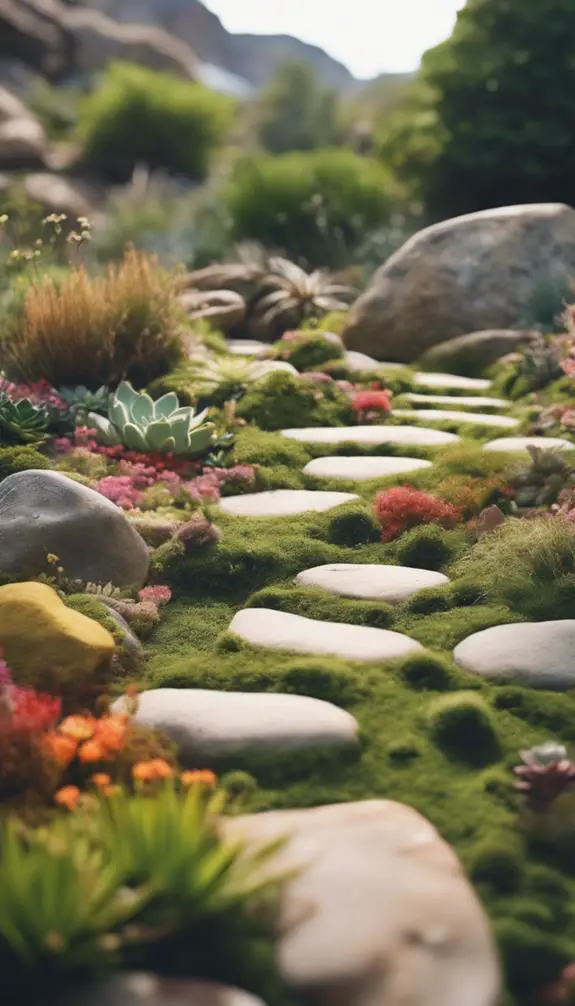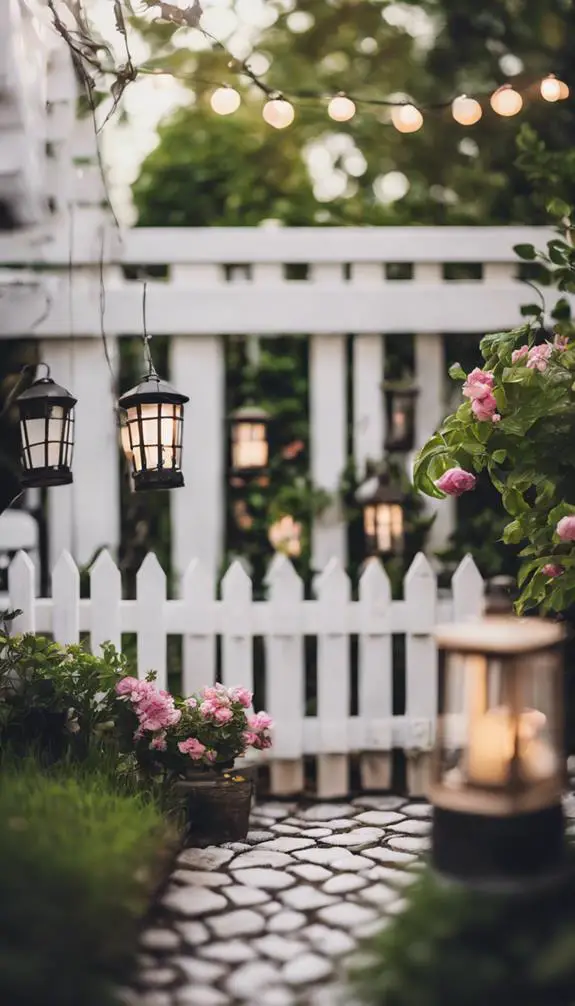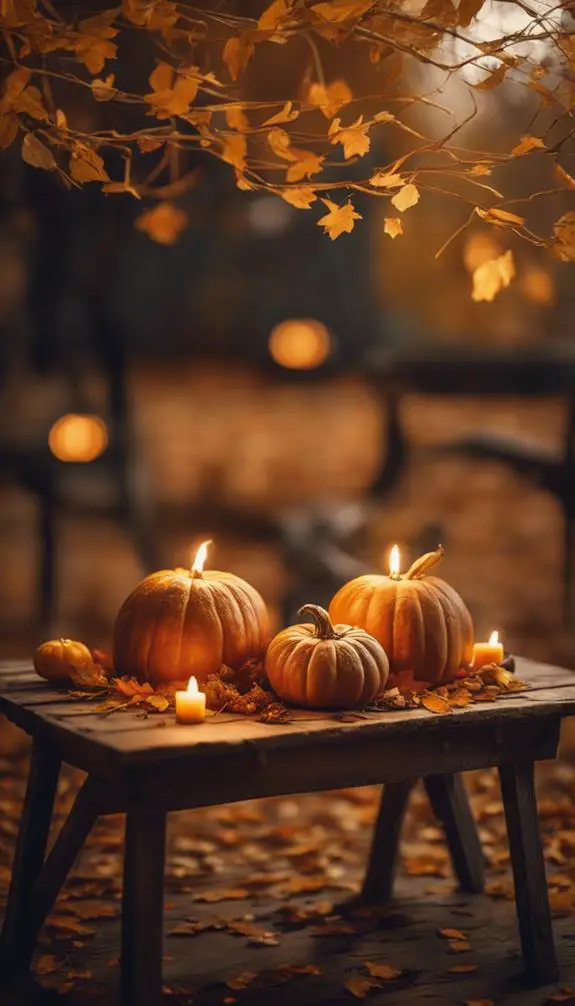As you step into the world of succulent landscaping, you'll discover a domain of possibilities for transforming your outdoor space. You can create visually striking patterns with succulents, incorporate modern accents like metal planters and geometric stones, and balance statement pieces with simpler elements to craft a unique look. But that's just the beginning. With so many design options to explore, from whimsical rock gardens to drought-tolerant lawn alternatives, you'll want to see what other inspiring ideas await you – and how you can bring them to life in your own backyard.
Modern Succulent Garden Designs
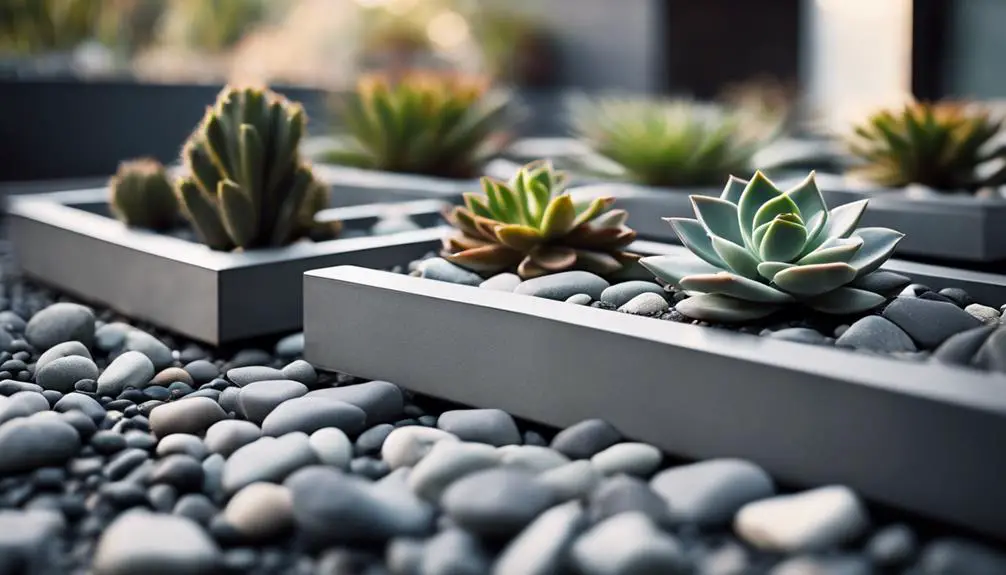
As you set out on creating a succulent landscape, modern succulent garden designs offer a plethora of innovative and visually striking options that can elevate your outdoor space.
You can incorporate succulent patterns, such as chevrons or herringbone designs, to add texture and visual interest to your garden. Modern accents like metal planters, geometric stones, or reclaimed wood can also enhance the aesthetic appeal of your succulent landscape.
To create a cohesive look, choose a few statement pieces and balance them with simpler elements.
For instance, pair a dramatic succulent arrangement with a minimalist planter or a bold-colored pot with a subtle succulent pattern. Don't be afraid to experiment with different heights, textures, and colors to create a unique and enchanting landscape.
Whimsical Rock Garden Creations
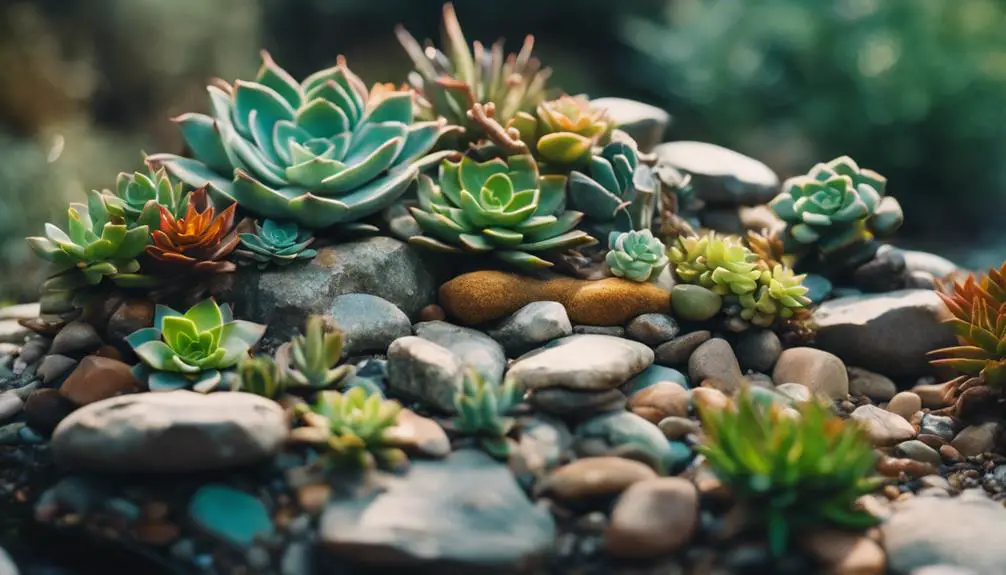
With a few strategically placed rocks and a dash of creativity, you can craft whimsical rock garden creations that transform your succulent landscape into a miniature world of wonder.
By incorporating unique rock formations, you can add depth and visual interest to your design.
Consider using rocks of varying sizes, shapes, and textures to create a visually appealing arrangement. For example, you can create a 'rock river' by placing smaller rocks in a winding pattern across your garden bed, or use larger rocks to create a 'rock mountain' focal point.
To add an extra layer of whimsy, incorporate whimsy accents such as small succulent-filled crevices or tiny decorative stones.
You can also use rocks to create a sense of movement by placing them in a way that suggests flow or energy.
Drought-Tolerant Lawn Alternatives
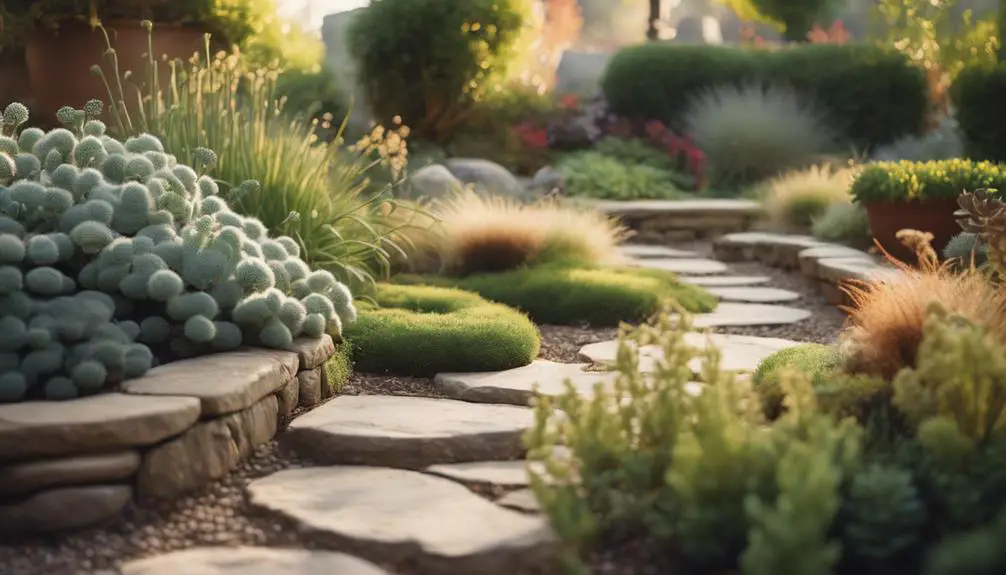
Your succulent landscape can ditch the traditional lawn and thrive with drought-tolerant lawn alternatives that not only conserve water but also add texture and beauty to your outdoor space.
As you explore lawn replacement options, consider the benefits of low-maintenance, eco-friendly turf alternatives. One popular choice is clover, which requires minimal watering and mowing. Another option is creeping thyme, a fragrant, walkable groundcover that can withstand heavy foot traffic.
For a more dramatic look, consider using succulent groundcovers like sedum or echeveria. These plants are designed to store water in their leaves, stems, or roots, making them perfect for water-conscious landscapes.
You can also incorporate decomposed granite or small rocks to create a visually appealing, drought-tolerant surface.
When selecting a lawn alternative, be sure to choose plants that are suitable for your climate and soil type. With a little creativity, you can create a stunning, low-maintenance landscape that showcases the beauty of succulents while reducing your water bill.
Succulent-Filled Vertical Gardens
You can take your succulent landscaping to new heights by incorporating succulent-filled vertical gardens, which not only add a stunning visual element to your outdoor space but also increase the planting area without encroaching on valuable floor space.
By using wall planters, you can create a lush, thriving oasis that appears to defy gravity. These vertical gardens are perfect for small spaces, as they make efficient use of available wall space while minimizing the need for extensive groundwork.
When designing your succulent-filled vertical garden, ponder the type of succulents you want to use. Choose varieties with similar growing conditions and light requirements to guarantee a harmonious and thriving arrangement.
You can also incorporate other plants, such as mosses or ferns, to add texture and depth to your design. As you create your urban oasis, don't forget to ponder the irrigation system and drainage, as these are vital components of a successful vertical garden.
With careful planning and attention to detail, you can create a breathtaking succulent-filled vertical garden that will elevate your outdoor space and provide a tranquil retreat from the hustle and bustle of daily life.
Coastal-Inspired Plant Combinations

As you craft your coastal-inspired succulent landscape, you'll want to select plant combinations that evoke the soothing, natural beauty of the seaside.
You can achieve this by pairing succulents with complementary textures, colors, and forms that mimic the beachy aesthetic.
Beachy Keen Plant Pals
By combining succulents with coastal-inspired plants, such as sea lavender, beach morning glory, and dune grass, you can create a beachy keen landscape that captures the essence of a seaside retreat.
This unique blend of plants will transport you to a coastal paradise, even if you're landlocked. To achieve this look, start by selecting succulents with a soft, muted color palette, such as echeveria or crassula, which will complement the calming tones of the coastal plants.
Next, incorporate plants with a beachy vibe, like sea lavender, which adds a soft, silvery hue and a delicate texture. Beach morning glory, with its bright yellow blooms, will add a pop of color and create a sense of movement, as if the waves are gently lapping at the shore.
Finally, add some dune grass to create a sense of texture and depth. As you combine these plants, you'll start to feel the coastal vibes and seaside charm of your beachy keen landscape.
With a little creativity, you can bring the beach to your backyard, no matter where you live.
Driftwood Accent Magic
To elevate your beachy keen landscape, incorporate driftwood accents that complement the soft hues and textures of your coastal-inspired plant combinations, adding a weathered, organic element that echoes the worn, sun-bleached wood found on the beach.
This unique accent will transport your outdoor space to the coast, creating a harmonious blend of natural elements.
You can use driftwood sculptures to create a focal point or scatter smaller pieces throughout your garden to add visual interest.
Weathered decorations like old anchors, nets, or buoys can also be incorporated to enhance the coastal vibe.
When pairing driftwood with succulents, choose plants with soft, powdery leaves or delicate stems to mimic the beachy feel.
Consider combining echeveria, crassula, or sedum with driftwood accents to create a visually striking display.
Seaside Succulent Harmony
You can craft a seaside succulent harmony by combining plants with contrasting textures, shapes, and colors, such as the powdery leaves of echeveria, the delicate stems of crassula, and the vibrant blooms of aloe, which together evoke the natural beauty of a windswept coastline.
To capture the essence of the Ocean Breeze, pair these plants with others that have a wispy, airy quality, like sedum or dymondia.
The resulting composition will exude Coastal Vibes, transporting you to a seaside paradise.
To take your design to the next level, consider the scale and proportion of your plants.
Balance larger, statement pieces like agave or yucca with smaller, more delicate species.
Don't be afraid to experiment with different containers, like weathered wooden planters or sea-weathered stone vessels, to add an extra layer of coastal charm.
Desert Landscape Inspiration

As you explore desert landscape inspiration, you're likely drawn to the vibrant, fleeting blooms that punctuate the arid landscape.
You'll discover that these desert beauty spots rely on a carefully curated plant palette, adapted to thrive in dry climates.
Desert Blooming Beauty Spots
Beyond the arid expanse of sandy dunes and rocky outcroppings, desert landscapes transform into vibrant oases, showcasing nature's artistry in Desert Blooming Beauty Spots.
As you venture into these natural wonders, you'll discover a tapestry of colors, textures, and forms that will inspire your succulent landscaping design. Desert Oases, like havens in the desert, are teeming with life, where cacti and succulents thrive amidst rocks, gravel, and sand. These Blooming Havens aren't just aesthetically pleasing; they're also tributes to nature's resilience and adaptability.
When designing your Desert Blooming Beauty Spot, consider the dramatic contrasts between light and shadow, as the intense desert sun casts intricate patterns on the landscape.
Incorporate native plants, like ocotillo and teddy bear cholla, to create a sense of place and authenticity. Use rocks, gravel, and decomposed granite to define spaces and create visual interest.
Dry Climate Plant Palette
In the harsh desert environment, a thoughtfully curated Dry Climate Plant Palette is essential for crafting a resilient and visually stunning succulent landscape that thrives in the face of extreme temperatures and limited water availability.
You'll want to focus on plants that are Climate Tolerant, capable of withstanding scorching heat and freezing cold. Succulents like Aloe, Agave, and Echeveria are perfect for this palette, as they've adapted to store water in their leaves, stems, or roots.
When selecting plants, consider their Soil Adaptation abilities. Some succulents thrive in well-draining soils, while others prefer moisture-retentive soils.
Mixing plants with different soil preferences will guarantee a dynamic and resilient landscape. For example, pair California Buckwheat with Desert Marigold, which prefer well-draining soils, alongside Globe Mallow, which tolerates moisture-retentive soils.
Succulent Container Garden Ideas
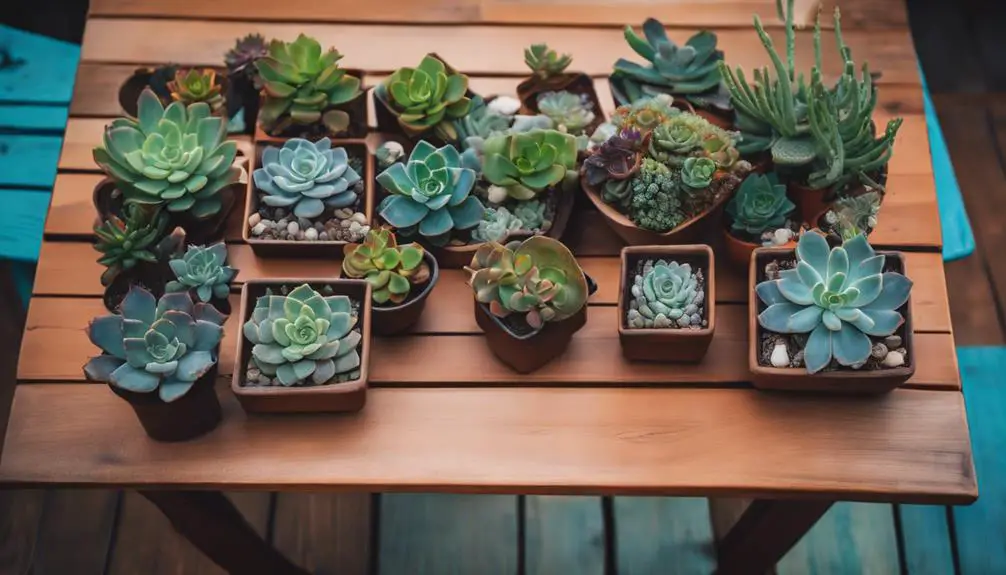
You can create a stunning succulent container garden by selecting a few statement pieces, like a dramatic echeveria or a trailing sedum, to anchor your design.
These Succulent Selections will set the tone for your arrangement, so choose wisely.
For a modern look, opt for sleek, minimalist Container Styles like concrete or ceramic pots.
Alternatively, add a touch of whimsy with vintage planters or macramé hangers.
When selecting succulents, consider their growth habits, colors, and textures to create visual interest.
Mix and match different species, like plump aloe, delicate string of pearls, and architectural agave, to add depth and dimension.
Don't be afraid to experiment with unusual containers, like wooden crates or woven baskets, to add an element of surprise.
Remember to balance your arrangement with a mix of tall, trailing, and compact succulents to create a visually appealing display.
With a little creativity, your succulent container garden will be a showstopper.
Edible Succulent Garden Designs
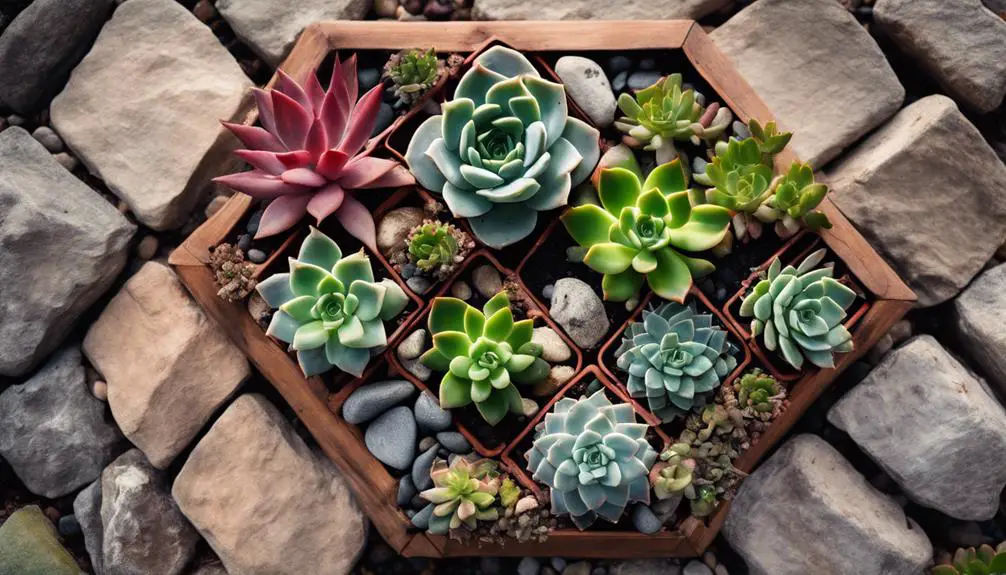
Harvesting fresh, succulent flavors from your own backyard has never been easier, thanks to edible succulent garden designs that bring together aesthetics and culinary delight.
You'll love combining succulents like aloe, agave, and echeveria with fresh herbs like basil, rosemary, and thyme to create a fruitful harvest.
By choosing the right succulent varieties, you can add a burst of flavor to your favorite dishes, from tangy salads to savory meats.
When designing your edible succulent garden, consider the climate and soil type in your area.
Succulents thrive in well-draining soil and full sun, making them perfect for warm, dry climates.
You can also incorporate vertical elements, like trellises or living walls, to maximize space and add visual interest.
Don't forget to include a mix of textures, colors, and shapes to create a visually stunning display.
With a little creativity, you can create an edible succulent garden that's both beautiful and bountiful.
Imagine snipping off a fresh sprig of rosemary to add to your roasted chicken or slicing into a juicy, succulent leaf for a revitalizing summer snack.
The possibilities are endless!
Succulent and Herb Garden Combinations

By pairing succulents with herbs in your garden, you'll create a dynamic duo that not only tantalizes the taste buds but also adds a visually striking element to your outdoor space.
Succulent pairings like echeveria and thyme or aloe and rosemary create a harmonious blend of textures, colors, and scents. These combinations will elevate your garden's aesthetic appeal while providing a bounty of fresh herbs for culinary delights.
To create a stunning succulent and herb garden combination, consider incorporating herb accents like basil, mint, or lemongrass to add a pop of color and fragrance.
Plant them alongside succulents with complementary shapes and hues, such as the delicate, wispy stems of sedum and the vibrant, variegated leaves of coleus.
Don't be afraid to experiment with different succulent pairings and herb accents to find the perfect blend for your garden. With a little creativity, you'll be enjoying a beautiful and bountiful succulent and herb garden in no time.
Low-Maintenance Succulent Ground Covers
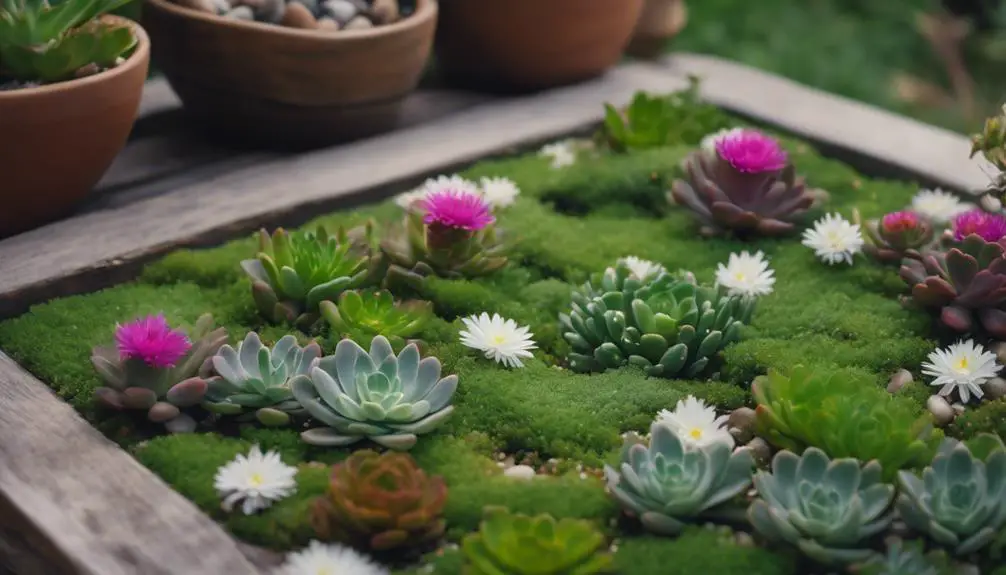
As you design your low-maintenance succulent landscape, you'll want to ponder two key approaches to ground covers:
Creating a dense succulent matting that suppresses weeds and retains moisture, or opting for spreading ground covers that naturally fill in gaps between pavers or stones.
Both methods will save you time and effort in the long run.
Dense Succulent Matting
In dense succulent matting, you can create a low-maintenance ground cover by planting multiple small succulents close together, allowing them to intertwine and form a lush, impenetrable carpet.
This technique offers several matting benefits, including reduced watering needs, as the plants' dense foliage shades the soil, retaining moisture and suppressing weeds.
Succulent carpets also require less pruning, as the closely spaced plants naturally control each other's growth.
To achieve a uniform mat, choose succulent varieties with similar growth rates and textures. Plant them 2-4 inches apart, depending on the mature size of the species.
As the plants grow, they'll form a dense, weed-resistant layer that's perfect for areas with low foot traffic.
Succulent matting is ideal for slopes, containers, or large areas where you want to minimize maintenance.
Spreading Ground Cover
You can take your low-maintenance landscaping to the next level with spreading ground covers, which spread quickly to fill gaps and create a seamless, succulent tapestry.
These Ground Cover Options are ideal for areas with poor soil or where you want to suppress weeds. Spreading Succulents like Sedum, Sempervivum, and Delosperma are perfect for this purpose.
They form a dense mat, choking out weeds and requiring minimal maintenance.
When choosing Spreading Succulents, consider factors like climate, soil type, and desired texture.
For instance, Sedum spurium has a delicate, creeping habit, while Delosperma cooperi has a more vigorous spread.
You can also mix and match different species to create a unique, layered look.
To guarantee successful establishment, plant them closely together, water well, and provide adequate sunlight.
With proper care, your Spreading Succulents will thrive, creating a stunning, low-fuss landscape.
Experiment with different Ground Cover Options to find the perfect combination for your outdoor space.
Succulent and Flower Bed Combinations
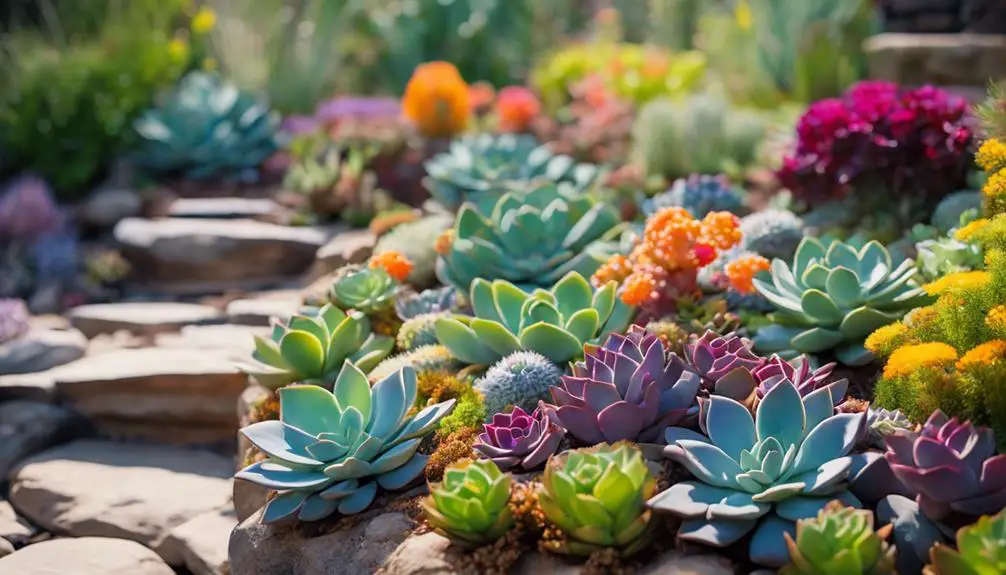
Combining succulents with flowers in your bed design creates a visually striking contrast between structural, water-storing plants and delicate, blooming flowers.
You can use succulents as accents to add texture and interest to your flower beds. For example, plant succulents like aloe or echeveria around the base of roses or hydrangeas to create a beautiful floral contrast. The succulents' geometric shapes and subtle colors will provide a stunning backdrop for the vibrant flowers.
To take it to the next level, experiment with different succulent accents to create unique combinations.
Pair soft, rounded succulents like sedum with delicate, pastel-colored flowers like petunias or pansies. Alternatively, contrast bold, architectural succulents like agave or yucca with bright, statement flowers like sunflowers or dahlias.
Creative Succulent Pathway Designs
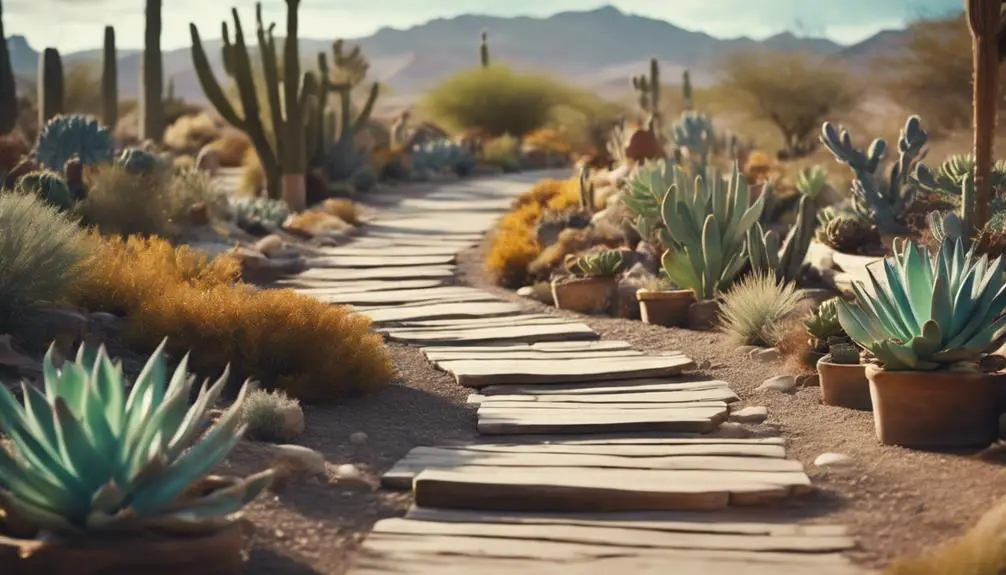
By incorporating succulents into your pathway design, you'll create a unique, low-maintenance, and visually striking feature that adds texture and interest to your outdoor space.
To take your design to the next level, consider incorporating succulent patterns into your pathway. You can create a repeating pattern using different species of succulents, or opt for a more random, organic look by scattering them throughout the path.
Another great way to add visual interest is by incorporating stepping stones into your design. You can use large stones as a focal point, or smaller ones to create a meandering path.
By combining succulents and stepping stones, you'll create a pathway that's both functional and beautiful. Don't be afraid to experiment with different shapes, sizes, and colors to create a look that's truly unique.
With a little creativity, you can create a succulent pathway that's the envy of the neighborhood.
Succulent-Themed Outdoor Decor Ideas
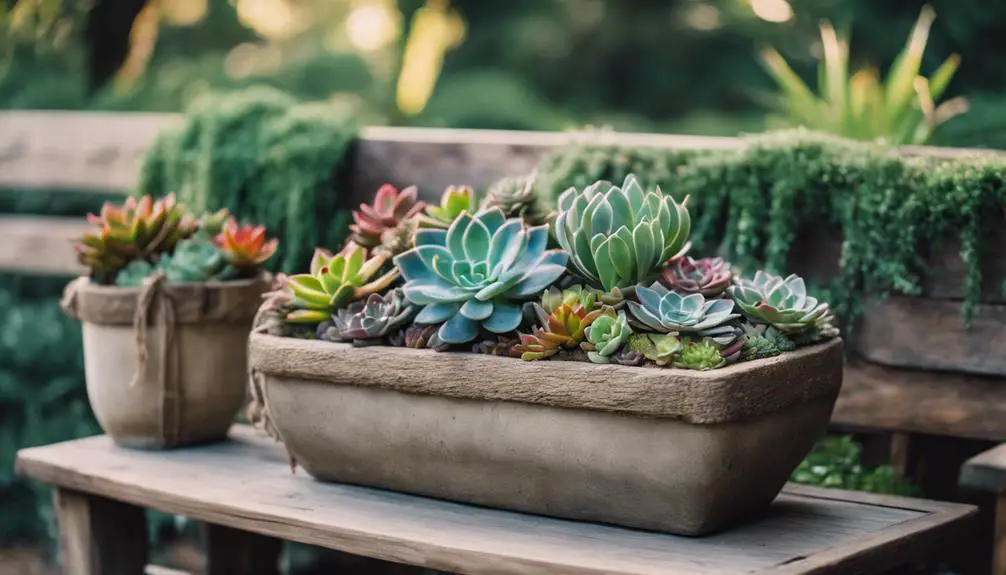
Succulents' unique shapes and colors inspire a wide range of outdoor decor ideas that can elevate your outdoor space from ordinary to extraordinary.
You can create a cohesive look by incorporating Succulent Accents throughout your outdoor oasis. Add a few statement pieces, like a geometric planter or a sculptural terrarium, to create visual interest.
For a more subtle approach, incorporate succulent-inspired patterns and textures into your outdoor furniture and accessories.
To take your outdoor space to the next level, consider creating an Outdoor Oasis that's entirely dedicated to succulents.
Use a variety of succulent species with different shapes, sizes, and colors to create a visually stunning display.
You can also incorporate other natural elements, like rocks, driftwood, or moss, to add depth and texture.
Don't be afraid to get creative and experiment with different arrangements and layouts until you find one that reflects your personal style.
With a little imagination and creativity, you can create a one-of-a-kind succulent-themed outdoor space that's truly unforgettable.
Frequently Asked Questions
How Often Should I Water My Succulent Landscape in Winter?
During winter, you'll want to water your succulent landscape sparingly, as plants enter winter dormancy. Check soil moisture by sticking your finger in; if it's dry, water lightly, but avoid overwatering, which can lead to root rot.
Can I Use Regular Potting Soil for Succulents?
When choosing soil for your plants, you shouldn't use regular potting soil, as it can retain too much water, causing drainage issues; instead, opt for a well-draining mix with a specific soil structure that prevents waterlogged roots.
Will Succulents Attract Pests or Rodents to My Garden?
You'll want to ponder pest control methods and wildlife deterrents, as succulents can attract unwanted visitors like aphids, mealybugs, and rodents. Use physical barriers, repellents, and organic pesticides to safeguard your garden from these unwanted critters.
Can I Grow Succulents in Full Shade or Low Light?
You'll find that some succulents can thrive in full shade or low light, but it depends on their shade tolerance. Select species like Aloe, Echeveria, or Crassula, which can tolerate low light, and provide the right conditions for them to flourish.
Are Succulents Safe for Pets and Children to Be Around?
When you're considering plants around pets and kids, you'll want to know that some succulents have toxic sap, so you'll need to choose pet-friendly alternatives with low toxicity levels to guarantee a safe environment for your loved ones.
Conclusion
As you bring your succulent landscaping ideas to life, remember to balance bold statements with subtle elements, and don't be afraid to experiment with texture, color, and height.
By incorporating modern accents, whimsical touches, and clever combinations, you'll create a one-of-a-kind outdoor space that showcases the unique beauty of succulents.
With these inspiring designs, you'll be well on your way to crafting a mesmerizing and low-maintenance landscape that thrives in harmony with nature.


